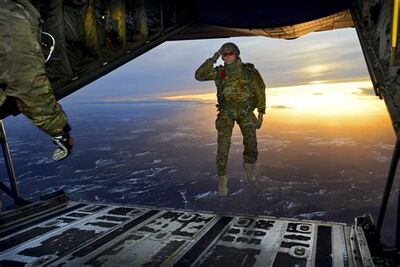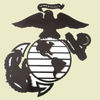The Assassination of JFK: Who was the “Mastermind” — Johnson or Dulles?
Sep 26, 2019 10:29:37 #
Michael Rich
Loc: Lapine Oregon
eagleye13 wrote:
I am curious to what your point is. br br That wa... (show quote)
In a fair society Johnson would have been convicted of conspiracy to assassinate the the President.
Sep 26, 2019 16:24:40 #
byronglimish wrote:
In a fair society Johnson would have been convicted of conspiracy to assassinate the the President.
Yep with an honest judicial system.
The PTB/CIA,etc. got away with assassinating our president.
Sep 27, 2019 09:51:38 #
I believe LBJ was a "FED" man. When "The Bank" is threatened, like a snake it bites back. Its "red flag" was Kennedy's ordering the printing of the "Congressional Dollar" backed by silver commodity. His hope was the replacement of the "FED" dollar, now termed, by Kissenger, the "Petro-dollar."
Sep 27, 2019 10:34:09 #
currahee506 wrote:
I believe LBJ was a "FED" man. When "The Bank" is threatened, like a snake it bites back. Its "red flag" was Kennedy's ordering the printing of the "Congressional Dollar" backed by silver commodity. His hope was the replacement of the "FED" dollar, now termed, by Kissenger, the "Petro-dollar."
When a President goes after the Banker's scam/money, they put their lives in danger.
Abraham Lincoln
William McKinley
John F Kennedy
Congressman Louis T. McFadden (several attempted assassinations)
Congressman McFadden
on the Federal Reserve Corporation
Remarks in Congress, 1934
AN ASTOUNDING EXPOSURE
________________________________________
Reprinted by permission 1978 Arizona Caucus Club
________________________________________
Congressman McFadden's Speech
On the Federal Reserve Corporation
Quotations from several speeches made on the Floor of the House of Representatives by the Honorable Louis T. McFadden of Pennsylvania. Mr. McFadden, due to his having served as Chairman of the Banking and Currency Committee for more than 10 years, was the best posted man on these matters in America and was in a position to speak with authority of the vast ramifications of this gigantic private credit monopoly. As Representative of a State which was among the first to declare its freedom from foreign money tyrants it is fitting that Pennsylvania, the cradle of liberty, be again given the credit for producing a son that was not afraid to hurl defiance in the face of the money-bund. Whereas Mr. McFadden was elected to the high office on both the Democratic and Republican tickets, there can be no accusation of partisanship lodged against him. Because these speeches are set out in full in the Congressional Record, they carry weight that no amount of condemnation on the part of private individuals could hope to carry.
The Federal Reserve-A Corrupt Institution
"Mr. Chairman, we have in this Country one of the most corrupt institutions the world has ever known. I refer to the Federal Reserve Board and the Federal Reserve Banks, hereinafter called the Fed. The Fed has cheated the Government of these United States and the people of the United States out of enough money to pay the Nation's debt. The depredations and iniquities of the Fed has cost enough money to pay the National debt several times over.
"This evil institution has impoverished and ruined the people of these United States, has bankrupted itself, and has practically bankrupted our Government. It has done this through the defects of the law under which it operates, through the maladministration of that law by the Fed and through the corrupt practices of the moneyed vultures who control it.
"Some people who think that the Federal Reserve Banks are United States Government institutions. They are private monopolies which prey upon the people of these United States for the benefit of themselves and their foreign customers; foreign and domestic speculators and swindlers; and rich and predatory money lenders. ….. (For the whole expose – Google: Congressman McFadden Fed expose)
"These twelve private credit monopolies were deceitfully and disloyally foisted upon this Country by the bankers who came here from Europe and repaid us our hospitality by undermining our American institutions. Those bankers took money out of this Country to finance Japan in a war against Russia. They created a reign of terror in Russia with our money in order to help that war along. They instigated the separate peace between Germany and Russia, and thus drove a wedge between the allies in World War. They financed Trotsky's passage from New York to Russia so that he might assist in the destruction of the Russian Empire. They fomented and instigated the Russian Revolution, and placed a large fund of American dollars at Trotsky's disposal in one of their branch banks in Sweden so that through him Russian homes might be thoroughly broken up and Russian children flung far and wide from their natural protectors. They have since begun breaking up of American homes and the dispersal of American children. "Mr. Chairman, there should be no partisanship in matters concerning banking and currency affairs in this Country, and I do not speak with any.
"In 1912 the National Monetary Association, under the chairmanship of the late Senator Nelson W. Aldrich, made a report and presented a vicious bill called the National Reserve Association bill. This bill is usually spoken of as the Aldrich bill. Senator Aldrich did not write the Aldrich bill. He was the tool, if not the accomplice, of the European bankers who for nearly twenty years had been scheming to set up a central bank in this Country and who in 1912 has spent and were continuing to spend vast sums of money to accomplish their purpose.
"We were opposed to the Aldrich plan for a central bank. The men who rule the Democratic Party then promised the people that if they were returned to power there would be no central bank established here while they held the reigns of government. Thirteen months later that promise was broken, and the Wilson administration, under the tutelage of those sinister Wall Street figures who stood behind Colonel House, established here in our free Country the worm-eaten monarchical institution of the "King's Bank" to control us from the top downward, and from the cradle to the grave. ……..
PRESIDENT JACKSON'S TIME
"One of the greatest battles for the preservation of this Republic was fought out here in Jackson's time; when the second Bank of the United States, founded on the same false principles of those which are here exemplified in the Fed was hurled out of existence. After that, in 1837, the Country was warned against the dangers that might ensue if the predatory interests after being cast out should come back in disguise and unite themselves to the Executive and through him acquire control of the Government. …..
"The danger that the Country was warned against came upon us and is shown in the long train of horrors attendant upon the affairs of the traitorous and dishonest Fed. Look around you when you leave this Chamber and you will see evidences of it in all sides. This is an era of misery and for the conditions that caused that misery, the Fed are fully liable. This is an era of financed crime and in the financing of crime the Fed does not play the part of a disinterested spectator. … "The Fed became law the day before Christmas Eve, in the year 1913, and shortly afterwards, the German International bankers, Kuhn, Loeb and Co. sent one of their partners here to run it.
THE GREAT DEPRESSION
"Meanwhile and on account of it, we ourselves are in the midst of the greatest depression we have ever known. From the Atlantic to the Pacific, our Country has been ravaged and laid waste by the evil practices of the Fed and the interests which control them. At no time in our history, has the general welfare of the people been at a lower level or the minds of the people so full of despair. …. As Agents of the foreign central banks the Fed try by every means in their power to reduce our favorable balance of trade. (Remember; this warning was written in 1933)
Sep 27, 2019 16:37:07 #
eagleye13 wrote:
The Assassination of JFK: Who was the “Mastermind”... (show quote)
Johnson wanted JFK out of the way so his 'Great Society' could work. He had lots of contacts to do it for him. I never bought the grassy knowle. Wrong trajectory. And a Russian doing it? How spy vs. spy can you get? In his affair with Marilyn Monroe, JFK made many enemies, but he was also protected he thought.
Sep 27, 2019 16:39:43 #
eagleye13 wrote:
What does this have to do with anything? All those people are dead.The Assassination of JFK: Who was the “Mastermind”... (show quote)
Sep 27, 2019 16:51:04 #
lpnmajor wrote:
Why would a guy, Johnson, who hated Kennedy with a passion, agree to play second fiddle?
My theory has always been that Johnson was behind the plot. That was further reinforced by the government hiding all the evidence for 75 years. That made me believe that the government knew Johnson was responsible but in order to maintain stability, they could not let us, the people know. So Johnson got away with it to protect the Union. Why else keep the evidence under wraps until everyone who was around when it happened, is dead? Why else?
Semper Fi
Sep 27, 2019 17:43:05 #
GmanTerry wrote:
My theory has always been that Johnson was behind the plot. That was further reinforced by the government hiding all the evidence for 75 years. That made me believe that the government knew Johnson was responsible but in order to maintain stability, they could not let us, the people know. So Johnson got away with it to protect the Union. Why else keep the evidence under wraps until everyone who was around when it happened, is dead? Why else?
Semper Fi
Semper Fi
Exactly!
The perps are gone.
Sep 27, 2019 21:58:26 #
Sep 28, 2019 12:28:34 #
Sep 28, 2019 12:32:00 #
GmanTerry wrote:
My theory has always been that Johnson was behind the plot. That was further reinforced by the government hiding all the evidence for 75 years. That made me believe that the government knew Johnson was responsible but in order to maintain stability, they could not let us, the people know. So Johnson got away with it to protect the Union. Why else keep the evidence under wraps until everyone who was around when it happened, is dead? Why else?
Semper Fi
Semper Fi
My take on it, is Johnson was not privy to the whole scheme/conspiracy.
Just the right man for the job.
Sooo many skeletons in his closet.
And he was not a very nice man.
Sep 28, 2019 12:59:08 #
badbob85037 wrote:
Kennedy and Johnson were not friends. They hated each other and Johnson receded what JFK accomplished before his body was cold. Yea Johnson was in on it. I think Oswald was a patsy and the CIA were in on it. Remember the speech JFK gave about the evil he wanted us to uncover and the news to report. That's what got him killed. It's to bad too because we didn't listen and the media was bought and paid for. A mastermind?! We are talking about democrats. The two words are not compatible.
Kennedy took over Johnson's place as the next Dem nominated. Kennedy was too popular to deny him the nomination.
Oct 18, 2019 11:14:00 #
Oct 18, 2019 11:22:10 #
promilitary wrote:
I don't know but it sure as hell wasn't a single gunman all by himself.
"I don't know but it sure as hell wasn't a single gunman all by himself."
That should be obvious to all.
So; who used Lee Harvey Oswald, and who had him erased?
If you want to reply, then register here. Registration is free and your account is created instantly, so you can post right away.




